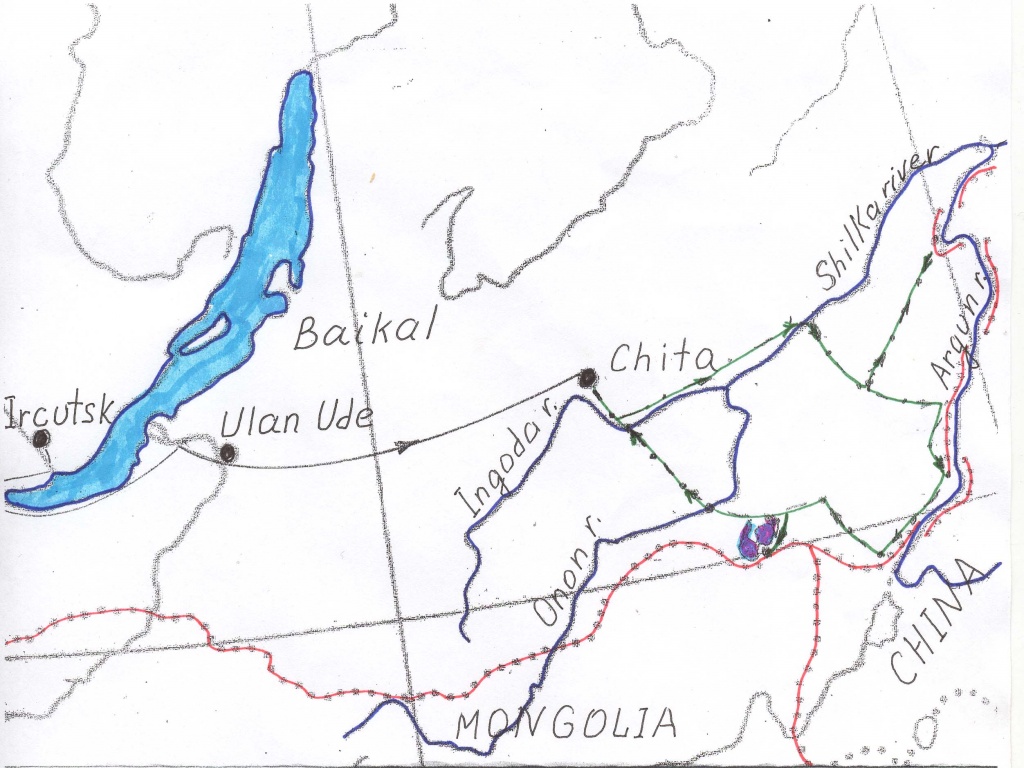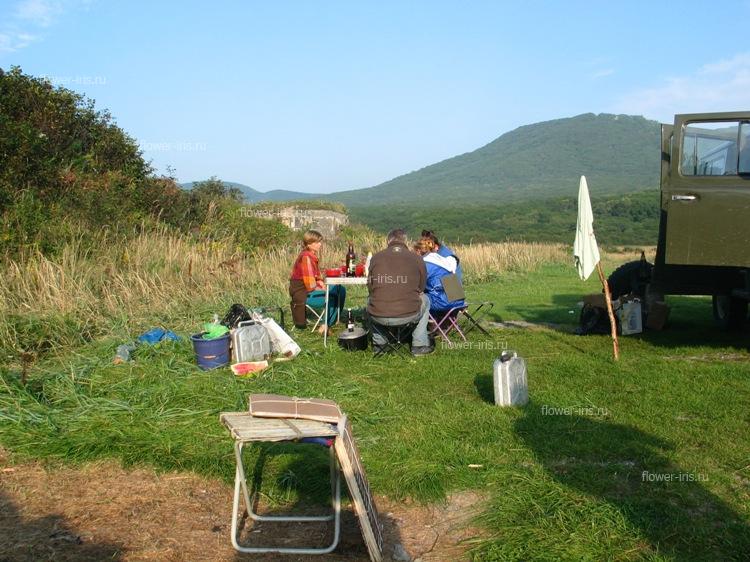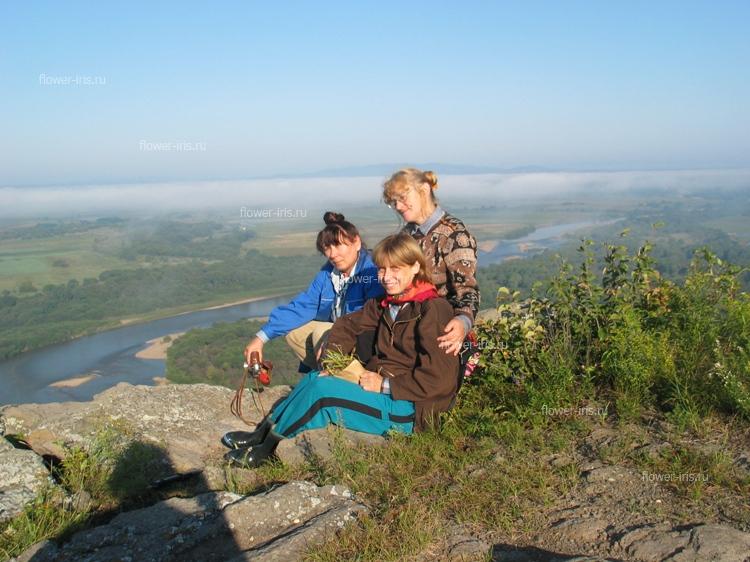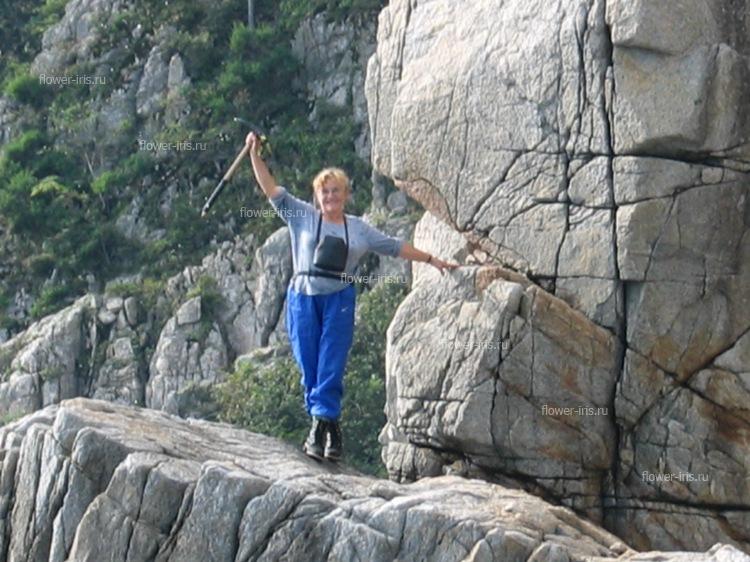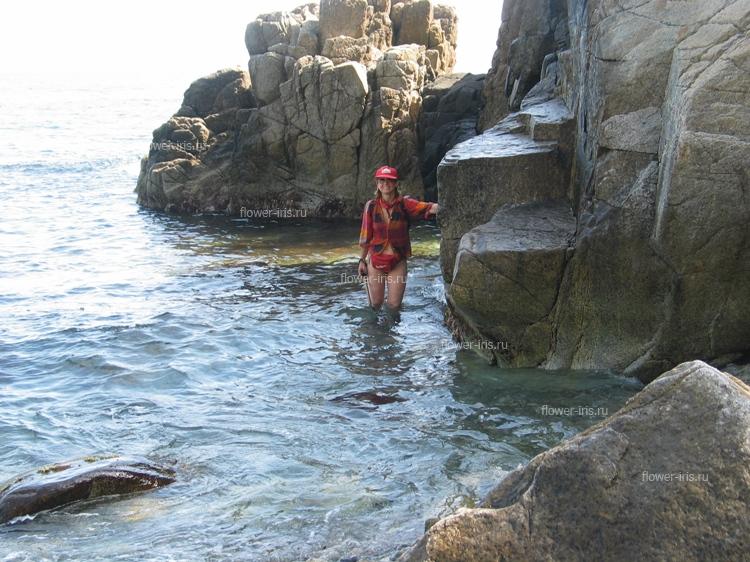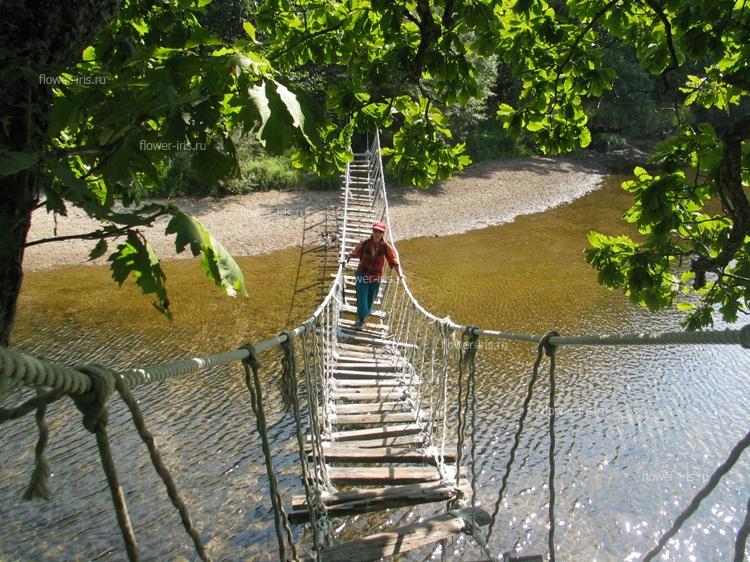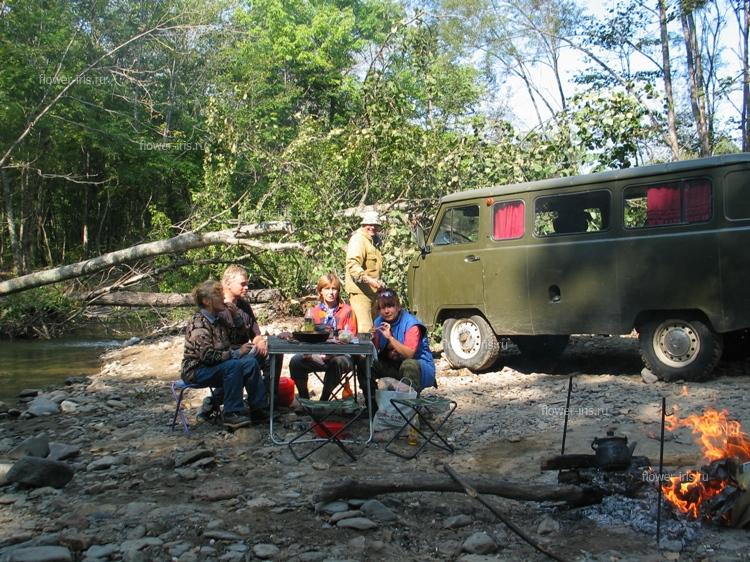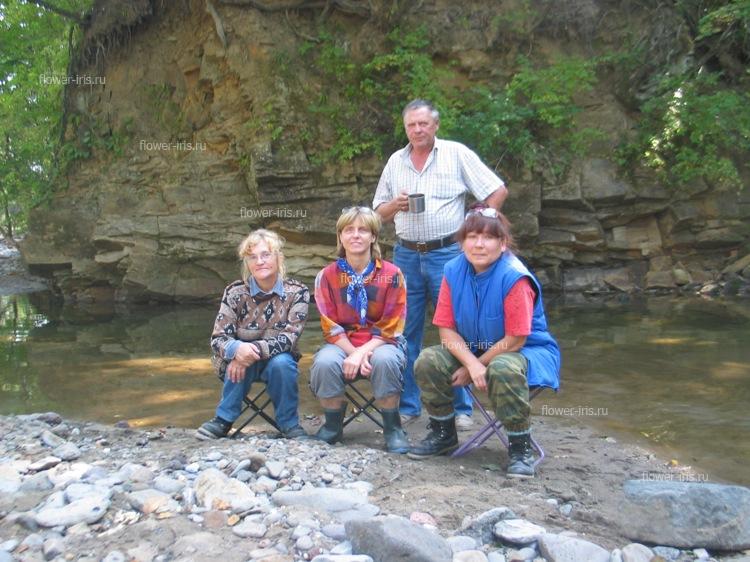|
News Camellian readings in St.Petersburg Photo Gallery |
Irises in PrimorjeHomepage → Tours and Expeditions → Irises in Primorje Our work with irises in St.Petersburg Botanical Garden is continued. Like earlier, a species addition of collection is resulted of exchange of seeds and collecting Iris species in nature. An expedition in Primorski region appeared to be a continuation of a number of carrying out before expeditions that included regions from the Northern Caucasus up to Transbaikalia. We continue to become acquainted with existent collections and with collectors who created them. In Primorje there are near 10 species of the genus Iris. Some of them were collected just in this place for the first time and described by such famous botanists as Maximovich and Fisher. Vladivostok there is the Botanical garden-institute, where a great iris-lover Ludmila Mironova works; she keeps a unique collection of these wonderful plants. One more time we went to an expedition throughout Russia to find wild iris species and to familiarize with the collection and its collector. Primorski region is one of the areas of the Far East and situated on the south of it, on the frontier with China and North Korea. From St.Petersburg we got to these places by airplane to Vladivostok, overpassing during the trip 7 time zones. Russians came to these places in 1650, native population of the Amur River and lower of the Ussuri River took out Russian citizenship, in the large region the first Russian strongholds were founded. Russian pioneers found less populated zone with rich plant and fauna world like those in Transbaikalia. Even in 1860 the bay Zolotoj Rog, where Vladivostok was founded, was nearly full of thousands ducks, gooses as well as white and black swans. The city is surrounded by sea from three sides. During the Second World War Vladivostok had been accepting many ships and boats from USA. They had been brining airplanes, steam locomotives, tinned stews, grain and a large number of other different things, which were so necessary for the front and army. It is wrong to think that the Far East is an inclement region. Anybody can meet here a thicket of bamboo in taiga, lianas of wild vine twining round a fir, in gardens apricots and on plantations melons and water-melons are grown ripe. Our trip we planed to start from the Botanical Garden of Vladivostok. Here we make the acquaintance of Doctor L. Mironova - a great lover and connoisseur of irises of Primorje. Near 30 years she has been cultivating species of the genus Iris, collecting them everywhere as well as growing them from seeds. She created here the irises of Primorje collection, which appears to be a base of studying of species biology, their propagation and introduction and which promotes to maintain of the irises of Primorje genofond. Probably, here in culture, there is the largest in Russia collection of I. insata Thunb., represented by15 samples from different regions of Primorje. L.N. Mironova deals with selection in a group of Japanese Irises. She create a stable sorts “Sineokaja”, (Blue Eyes), “Temnaja noch” (Dark Night), “Primorje”, “Sirenevaja Dymka” (Lilac Haze), “Rosovoje oblako” (Pink cloud), “Pervyj vals” (The first waltz) etc. Many of them were highly estimated at the International level and were included in registers (Iris Checklist, 2001; Registrations..., 2001). All of them are flowered and borne fruits. They have very various colour: from light-blue, blue, blue-violet, purple up to deep-violet. The first two days were devoted to investigation of iris collection and preparing to the trip. We decided to make two trips: one – to the north-east for a week and another to the south of Khasan region to the frontier of the North Korea for one more week. For these purposes we had an all-wheel drive, very comfortable car for 6 people, with carrying capacity 800 kg. Our expedition included 7 persons, all of them like us dreamed to see many new and interesting. In the city we have done all necessary shopping for the trip. We have visited a famous Chinese market, where everyone can bay everything, even different animals and living creatures, including snakes (that was used by one of our colleges). We limited our buying with waterproof coats, cups and some exotic tacking for fishing and obtaining squids. We have arrived from Vladivostok in September 8, 2003. In the first day we have driven 250-300 km to the east. At last, we have seen the River Ussuri. In the times of R.Maak the river was navigable over its flow. According an agreement of Aigun tract, in May 16, 1858 the Usuri has been included in Russian Imperia and accepted to be a border between Russia and China from the Amur up to creek of the Sungachi River. In upper course of the river during our trip there was less of water, we even didn’t try to fish. Irises were not yet. For the Botanical garden we collect seeds of Maackia amurensis, Lilium pulhellum, Clematis mandshurica etc. At the bay of the River we made the first overnight stop. The next day we arrived to the settlement Breevka, where we saw the first irises. I. laevigata smoothly bended round a stream and behind a cemetery on bog there were a large number of this species. There were a lot of bolls with seeds. Here we made our first collections. After that, over passing near 100 km, we appeared in the centre of mountain massive. During ascent a forest behind the car windows became another. From deciduous oak woods and groves it changed into daer fir forest, in which comfortably grow two spruce species and many other plants. An evening would be near, a rain began to drop and we made overnight stop in this gloomy but beautiful place. At night in mountains males of deers sounded. It’s a pity – these beautiful animals are not numerous. In the morning because of strong rain we afraid to go by car and went up the mountains by feet, but how many beautiful plants we have seen! Along the way the forest changed its composition and colour, among herbs we were able to see orchids, peonies, rare ferns and other plants. But soon trees had been left behind and we saw wonderful mountains. Very near one of the highest point of the range Sikhote-Alin – mountain Snezhnaja (Snowy) – have been seen. The River Ussuri is started here. All interesting plants: different maples, rhododendrons, euonymus (wahoo), cedar stayed behind, but to this high place native inhabitants come to pick up red whortleberries. Taking in account all difficulties of the way the berry appeared to be really gold. In our camp we returned in the late evening, we didn’t feel the feet! Choosing a route toward a sea coast we decided to select the nearest way - according the map the road through mountains marked as rather good. As a result we went to the Lazovskij reserve near 70 km along to the dangerous wood track, near 6-7 hours. We had to spend the night right on the road. We met finders of ginseng. A modern finder is just unlike the same one of past time, when people went to mountains along with basket on his back. People whom we have met arrived in taiga on lorry and made a little camp. Just in these regions there is a population of one of the most beautiful but, may be, dangerous animals in the world – Ussuri tiger. Now there are a little more than 100 individuals. Hunting for them is forbidden but never-the-less, the population has been decreasing, obviously, because of reducing of forage reserve. In the Far East there are very medicinal plants, we have a possibility to see and collect many of them, such as eleutherococcus, schizandra, ginseng etc. In the morning, without spending a lot of time to a breakfast, we followed towards a seacoast. In vicinities of the Lazo city we have collected I. ensata and I. sanguinea. At expanded meadows irises grew spontaneously. We could only imagine a great variability of colours and tints in flowering irises in the summer. We were happy and collected seeds and herbaria. On the way to the coast in vicinities of the Glazkovka settlement we were successful in collecting I uniflora. And bought a wonderful honey… It’s only a pity that it was September and we couldn’t completely enjoy an appearance of astonishing motley grass. One of the most interesting our stop-place in the first part of the trip was near the Lazovskij reserve, 5 km to south from the Glazkovka settlement. We planned to spend here two nights and then moved to the Olga Bay. After a long way everybody liked to swim in the sea. But it was not safely. It is necessary to go to the depth very carefully to prevent stepping on sea-urchins; there were a lot of them on the bottom. But we also became a danger for sea-urchins, because their delicatessen high-calorie meat rich with different useful elements may be eaten fresh, what was offered to us by our fellow travellers. On the coast there were a lot of shells of sea cristaes, it is one more delicatessen. We felled that native people come here to have a rest. We have taken some shells as souvenirs. After a little rest from the travel we went to find irises. The first that I found was I. setosa. It looks very like the group of bearded irises, because of its wide and soft leaves. When we found exemplars with boll, all doubts left us – the bolls sounded like a rattle for little children, what is very characteristic for this species. That evening was wonderfully calm, but red sky sunset was an evidence of close wind and rain… In the morning we went to Lazovskij reserve and found I. uniflora in oak forest as well as at the coast near water. It was a little rainy. When we returned to the camp, while the whether became worth, all our friends were waiting for us. Things were gathered and put in the car. It turned out that it was declared by radio about coming of typhoon Maemi, which has already resulted to great destroys in Korea and Japan. By the mean, Lazovskij region, where we situated was mostly that other exposed by typhoons. Sometimes roads were washed away and bridges were broken, so local botanists decided not to run risks and returned to the garden. The next route they decided to start a day earlier. We moved back under hard rain, but in spite of that we made some stops for collecting populations of I. sanguinea and I. ensata. But when we got across a mountain pass, the whether is fine. In the Botanical garden we returned in the late evening September, 13. One day was needed for further route. At the same time we obtained possibility to visit a local ocean museum (?) and went to a railway station, which is famous by finishing the longest railway in the world – 9.288 km. Transsiberian main line, which was built in the beginning of XX century is recorded in the Gynness’s Record Book! In the evening we walked along the Amur Gulf, where we fishing for crabs and ostraceans. In the early morning we arrived towards the lake Khanka. It is a very great lake 60 km in width and 85 km in length, small part of which belongs to China. Full bogs surrounded large areas around the lake make environment less attractive and desolate rice fields only redouble it. The lake is not deep, so even a little wind resulted to great waves. Our aim was to visit the settlement Komissarovo, where 150 years ago a herbarium samples of I. ventricosa had been collected. We stopped at the coast of a little lake. And for the first time we were successful to fish and make a fish-soup. In oak forests I. uniflora was grown, at the open meadow we found I. sanguinea, and I. ensata isolated. Unfortunately, in neighbourhoods of the settlement Komissarovo we don’t find I. ventricosa. Never-the-less we obtained possibility to collect new populations of I. ensata, I. laevigata, I. sanguinea and I. uniflora. For our colleges from the Vladivostok Botanical garden it was very interesting to collect seeds of practically all plants. Sometimes we had to eat wild vine in order to obtain seeds for the Botanical Garden. Sometimes families of pheasants flied from under our feet. We had to collect water plants. In one lake we found very rare vanishing species Euryale ferox Salisb. We arrived up to the memorial of nature “Senkina Shapka” (Senka’s Cap), it is a high mountain with flat top. A part of our group went to find a place for overnight stop, while we went to find irises. We saw a lot of I. uniflora. Also we collected here I. mandshurica. It was described by Maximovich just from these areas. It is a species from the section Psammiris. In Siberia its relative I. humilis is grown, and in European part such one - I. arenaria. Very important for me appeared to see and collect this species in wild nature. Our friends found nice place for overnight stop – near a river. Next day we went to Khasan region. We arrived towards the south to the place of the most interest for all participants of our expedition. Here, in the south of the Primorje region, we saw many beautiful lakes. There are Inmost, reserved, less visiting points of wild nature. The first half of way to this place we met small settlements, in one of them we stopped to treat a local milk meal – Barenets. It is made from milk, which is heated in oven for a long time. It becomes dense and covered by dark-brown pellicle. Then, without any adventures we arrived to frontier zone. The road dodged among overgrowth of rush, sometimes close to the Posjeta Bay. Just in the water in the sea dozens of herons stayed without paying any attention to us. At last we have seen a very beautiful lake, named the Lake Lotos (Lotus). It is one of the places, where exclusive wonderful plant Nelumbo komarovii grows. In the end of Jule – beginning of August its large pink flowers and great leaves leave an indelible impression. In September we only imagined nice pictures of flowering lotus. Here our colleges collected relict plants – Trapa natans. Its beautiful carved leaves covered a water of the lake. On hills in addition to other plants we saw very unusual oaks (Quercus) with rather large leaves and original shaggy ! A size of some leaves were 30 cm in length. This Quercus dentate comes at the territory of Russia only several kilometres and I have seen it for the first time. Somewhere very near there was a border with North Korea. We drove along the road parallel railway towards Korea. A train with only one carriage followed away. It seems there is no an intensive connection between our countries now. We went to the cape Mramornyi. In this place we planned to find I. ventricosa and I. vorobievii. Never-the-less we were not successful again. In overgrowth of waist-high grass it was very hard to find irises after their vegetation. However, in the morning one more species – Iris oxypetala – was found at our stop-place. It grew just on the way near the cape Mramornyi. We climbed up a vertical rock and then went among rich motley grass, what was very hard and sometimes really impossible. We had to carefully search this overgrowth to find irises. At last we found I uniflora and I. ensata. This stop-place appeared to be unique because we saw for the first time what fishes live in this region. Species composition of fish in the Far East is noticeable differ from our common in the European part of Russia. Our neighbours caught grey mullet, goby and Siberian salmon. They share with us. It was a very good present, because the next evening would be the last and we could cook an unusual dinner consisting from fish-soup and roast fish. We remembered one more event in this place. In the evening, in twilight, a shot crash out and in a moment the sky became dark, turn over one large black cloud – over our heads thousands of wild ducks flied towards the gulf. It took our breath away. Everyone of our group never saw so many ducks before. Here our collection of irises was added by new samples of species, which were already collected in other regions. They are I. uniflora, I. ensata, I. sanguinea. In total, for the Herbarium of the Botanical Institute there were collected ! sheets, that is, obviously, added the rich Herbarium’s collection. On the back way we again stopped in the settlement Kraskino, where several new populations of I. vorobievii may grow. We were looking for it again, but again didn’t find it. Later, in the Botanical garden L. Mironova would give me some seeds and rhizomes of this species. Further stops added only I. uniflora, I. ensata, I. oxypetala. On the way we came to get Rhododendron schlipenbaha. In whole we collected 7 species of the genus Iris (33 taxa). Several times tires in the car broke and we had to repair them ourselves. During our trip we had been driving about 2000 km. In the late evening of September we returned in Vladivostok. And for a long time we couldn’t go to slip – we packed plants and individual things, because our plane would fly back in the early morning. During our expedition we have been collecting almost all species of iris, growing in Primorje. The rest were gifted by kind hosts of the Botanical garden. We were very grateful to Ludmila Mironova and to Ludmila Pshennikova – scientific workers of the Botanical Garden-Institute in Vladivostok for organization of our expedition, especially to L. Mironova for accurate definition of our route, allowing to collect maximal amount of irises. This trip also allowed to strike up an acquaintance and contacts with scientific workers of the Botanical garden and Biological-soil Institute. Here we had an interesting meeting with Dr. N.S. Pavlova, who described a new species I. vorobievii from Khasan region and who considers that I. mandshurica is a synonym of I. humilis. Carefully studying typical samples, living plants, microstructure of seeds of these species we, together with L. Mironova resulted in conclusion that all above mentioned species have an independent status. About that fact we have already written joint article and sent it the Botanical Journal. The described trip was realized because of support from the Fund of the American Iris Society. It resulted in the following: observations on wild species of the genus Iris were conducted, living plants, seeds, Herbarium materials were collected, what considerably added scientific collection of the Botanical garden in St.Petersburg. This expedition was a final in a series trips over Russia to search irises, what allows tocomplete in autumn 2005 my scientific work concerning introduction and protection of species of the genus Iris in Russia. Alexeeva N. Irises in Primorje // SIGNA. Molalla (USA), Fall, 2006. N 77. P. 3877-3883 |


 Eng
Eng

